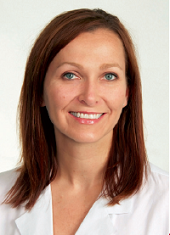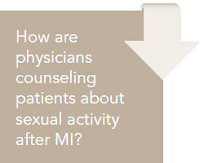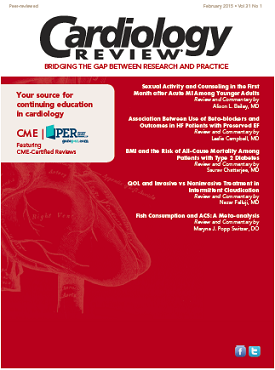Publication
Article
Cardiology Review® Online
Sexual Activity and Counseling in the First Month after Acute MI Among Younger Adults
Author(s):
It is widely accepted that sexual activity is an important component of quality of life for men and women with cardiovascular disease (CVD), as well as for their partners, and is a safe activity, in general. Yet, older studies show that most CVD patients do not believe they have been educated by health care providers on when to resume sexual activity or any necessary restrictions following acute myocardial infarction.

Alison L. Bailey, MD
Review
Lindau ST, Abramsohn EM, Bueno H, et al. Sexual Activity and Counseling in the First Month After Acute Myocardial Infarction Among Younger Adults in the United States and Spain. A Prospective, Observational Study. Circulation. 2014;130:2302-2309.

As cardiovascular disease remains prevalent worldwide, acute myocardial infarction (AMI) is commonly seen. Historically, most patients were older when faced with AMI. However, in contemporary studies, about 20% of all AMI occurs in younger adults (≤55 years of age), with women representing approximately 40% of these younger patients.1 It is widely accepted that sexual activity is an important component of quality of life for men and women with cardiovascular disease (CVD), as well as for their partners, and is a safe activity, in general. Yet, older studies show that most CVD patients do not believe they have been educated by health care providers on when to resume sexual activity or any necessary restrictions following AMI.2,3 To address this, most cardiovascular societies have released guidelines strongly encouraging an early discussion regarding sexual activity with the patient and his or her partner after AMI and minimization of restrictions (Table 1).4-7For younger patients with AMI, the contemporary management of sexual activity discussions and recommendations is largely unknown.
Study Details
The Variation in Recovery: Role of Gender on Outcomes of Young AMI Patients (VIRGO) study was a prospective, longitudinal study of younger patients (18 to 55 years of age) suffering an AMI.1 The goal of the trial was to investigate several aspects of the short-term recovery after an AMI including sexual activity, sexual function, and the patient’s experience of counseling about sexual activity after an AMI. Previous studies of older AMI patients suggested that women were less likely than men to receive sexual activity counseling; thus a 2:1 sample of women to men was planned for enrollment.
Hospitalized patients with AMI were recruited from 127 sites in the United States and Spain between August 2008 and January 2012. A standard definition of AMI was used for inclusion that included elevated cardiac biomarkers with evidence of acute myocardial ischemia as evidenced by symptoms and/or ECG changes of ischemia.8Patients were excluded if they were admitted to the enrolling site >24 hours after presentation; if they were incarcerated; did not speak English or Spanish; were unable to provide informed consent or be contacted for follow-up; developed elevated cardiac markers because of elective coronary revascularization; or had an AMI resulting from physical trauma.
The overall participation rate was 65% among 5422 patients meeting eligibility criteria. Of the 3501 patients enrolled, 67% were female (N=2349) and 85% were from the United States (N=2985). Baseline and 1-month follow up data were used for this study.
Baseline data included the usual patient demographics as well as questions regarding adult sexuality (adapted from prior large-scale studies on the topic) including partner status, sexual activity status, and attitudes about the importance of sex in the 12 months before AMI. Baseline data was collected via a face-to-face interview during the index hospitalization. Metrics of physical functioning, stress, and depression were also assessed using standardized instruments: 12-item Short-Form Health Survey Physical Composite Score (SF-12 PCS) for physical functioning; the Perceived Stress Scale (PSS); and the 9-item Patient Health Questionnaire (PHQ-9) for depression. Additionally, elements of the Global Registry of Acute Coronary Events (GRACE) Risk Score were prospectively collected and used to predict 6-month mortality in these AMI patients.
Follow-up data were obtained 1 month after AMI via a phone interview. Sexual activity, attitudes (importance, motivation), function in the 12 months before AMI, physician counseling about sexual activity after AMI, and physician recommendations were assessed at this follow-up call.
Bivariate analyses were used to compare gender differences in demographics, psychosocial, and health characteristics; pre- and post-AMI sexual activity, sexual function and importance; and communication with a physician about sex since the AMI. Additionally, comparisons were made between countries of enrollment. Gender and country differences were compared using 2-sidedχ2 or Fisher exact tests. Models were adjusted for factors found to be associated with the outcome in prior studies and a modified Poisson regression model was used to estimate relative risks (RR).
Baseline characteristics reveal similar age and gender distributions across countries; however, the United States had a higher percentage of black participants (Table 2). Men and Spanish participants were more likely to be married or cohabitating and the majority of participants had at least a high school education. Women had significantly higher rates of stress and depression and lower physical functioning at baseline compared with men. Most participants were sexually active in the 12 months prior to suffering an AMI, with about half experiencing at least 1 sexual problem during that time period.
At 1 month, follow up was completed by 92% of participants. Rates of missing items for sexual activity and functions were low at 0% to 6.7%. Sexual activity was substantially lower in the first month after AMI than in the previous 12 months for both genders and in both countries. Of those patients who were sexually active pre-AMI, only 54% of women and 63% of men had resumed sexual activity by 1 month post-AMI. Importantly, the majority of women and men rated sex as important both pre- and post-AMI.
The overwhelming majority of patients of both genders felt it was appropriate for their physician to discuss sexual health after AMI. Likewise, they felt comfortable discussing sexual issues with a physician. However, only 12% of women and 19% of men had a discussion with a physician about sex in the month after an AMI. Among these, the discussion was more likely to be initiated by patients in the United States, whereas it was more evenly split between patient and physician in Spain. About two-thirds of patients were given restrictions regarding sexual activity after AMI, with recommendations including keeping heart rate down, taking a more passive role in sex, and limiting sex altogether. Despite this, the majority of patients were completely satisfied with the recommendations they received from the physician.
Several factors were associated with lack of physician counseling regarding sex after AMI. These include female gender (RR, 1.07; 95% confidence interval [CI], 1.03-1.11), older age (RR, 1.05; 95% CI, 1.02-1.08 for 10-year increments), and sexual inactivity at baseline (RR, 1.11; 95% CI, 1.08-1.15). Among those patients receiving sexual activity counseling, those with poorer physical function were slightly more likely to receive restrictions (adjusted RR, 1.07, 95% CI, 1.01-1.13 per 10-point decrements), but gender was a more important predictor of restrictive recommendations. In the United States, women were less likely than men to be given restrictions regarding sexual activity (adjusted RR, 0.86;95% CI, 0.74-1.00). However, in Spain, the opposite was true and women were more likely to be given restrictions on sexual activity (adjusted RR, 1.38; 95% CI, 0.95-2.02). Overall, women in Spain were significantly more likely to be given sexual activity restrictions than women in the United States (adjusted RR, 1.36; 95% CI, 1.11-1.66).
Despite practice guidelines strongly recommending a physician-led discussion regarding sexual activity after AMI, this rarely occurs with younger patients in contemporary practice. Methods to improve the patient-physician discussion about sexual activity after AMI should be explored and current guidelines incorporated into sexual activity recommendations for our younger patients with AMI.
Commentary
Too many patients fail to receive counseling on sexual activity post-MI
Cardiovascular disease (CVD) is the leading cause of death in the United States and is a highly prevalent condition. About 600,000 people will suffer a first cardiac event and an additional 300,000 will suffer a recurrent event.9 Because of advancements in care, mortality rates have declined and individuals are living with CVD for longer periods of time. Changes in sexual activity after a cardiac event are well described and may impair the patient’s quality of life, negatively affect psychological health, and strain marital or other important intimate relationships, leading to depression and anxiety.4 Altogether, this can have important implications for the patient’s overall compliance rates and long-term CV health.
In this contemporary study of younger patients with an AMI, very few were counseled regarding sexual activity. This is the case despite guidelines advocating early discussions regarding sexual activity in the post-AMI patient—a group of patients that was sexually active prior to the AMI—and despite patient interest in physician advice and patient comfort with the topic. One must assume that this lack of discussion is related to several factors centered on limited knowledge and comfort of physicians to have this discussion, as well as time constraints and current processes of care that do not include sexual activity counseling as part of the discharge process.
Guidelines recommend a return to sexual activity within 1 week after uncomplicated MI if there are no cardiac symptoms. In general, sexual activity can be assumed to be equivalent to mild to moderate physical activity in the range of 3 to 5 metabolic equivalents and is the cause of <1% of all AMIs despite the frequently played-out clichés.4 Despite these recommendations, the patients who did receive sexual activity counseling were most frequently restricted. The recommendations were varied and did not appear to be based on patient-centric factors like comorbidities or functional status, but relied more on age and gender. Certainly, physician cultural characteristics likely contribute to the recommendations and may best explain the restrictions on sexual activity suggested to women in Spain. However, current guidelines do not recommend different recommendations for patients after AMI based on heart rate or perceived exertion during sex, although these modifications were commonly recommended.
Counseling about sexual activity following an AMI is an appropriate discussion for men and women of all ages. Guidelines exist that can educate the health care provider on the CV risks associated with sexual activity, provide background knowledge to improve provider confidence in starting these discussions, and reinforce the current recommendations.4-7 Having a healthy sex life can affect quality of life, stress, and depression levels as well as contribute to improved patient compliance.10 Our patients expect these discussions in the current era and feel comfortable approaching the topic. This contemporary study of younger patients with AMI highlights that there is much progress to be made in this arena.
Table 1. Summary of recommendations for post-myocardial infarction (MI)sexual activity guidelines.
Organization
Recommendations
American Heart Association
Scientific (AHA) Statement (2012)4
Sexual activity is reasonable 1 or more weeks after uncomplicated MI if the patient has no cardiac symptoms during mild to moderate physical activity (Class IIa; Level of Evidence C).
AHA and ESC Council on Cardiovascular Nursing and Allied Professions (2013)5
Tailor sexual counseling to the individual needs of the patient, regardless of age and sex, and offer it to patients as well as patients’ partners (Class IIa; Level of Evidence B). Psychological factors including fear, anxiety, and depression can adversely influence participation in sexual activities in patients with CVD (Class I; Level of Evidence B).
European Society of Cardiology
Guidelines (ESC) (2012)6
Sexual activity can be resumed early if adjusted to physical ability.
American College of Cardiology
Foundation (ACCF)/AHA
Task Force on Practice
Guidelines (2013)7
After release from the hospital, the plan of care for patients with ST-segment elevation MI (STEMI) should address in detail several complex issues, including sexual activities.
Adapted from Table 4, Lindau et al. Sexual activity and counseling in the first month after acute myocardial infarction among younger adults in the United States and Spain. Circulation. 2014;130:2307.
Table 2. Selected characteristics of VIRGO study participants:baseline (12 months prior to AMI) and 1 month after AMI
Baseline, No. (%)
Overall
United States
Spain
Women
N=2349 (67)
Men
N=1152 (33)
Women
N=2009 (67)
Men
N=976 (33)
Women
N=340 (66)
Men
N=176 (34)
Median age (range)
48 (44-52)
48 (43-52)
48 (44—52)
48 (44—52)
47 (42—51)
47 (42—51)
Race, No. (%)Black
437 (19)
113 (10)*
428 (21)
107 (11)*
9 (3)
6 (3)
White
1781 (76)
961 (84)*
1463 (73)
796 (82)*
318 (94)
165 (94)
Other
127 (5)
76 (7)*
115 (6)
72 (7)*
12 (4)
4 (2)
Married/cohabitating, No.(%)
1294 (55)
735 (64)*
1054 (53)
607 (62)*
240 (71)
128 (75)
138 (6)
47 (4)
42 (2)
16 (2)
96 (30)
31 (20)
Psychological characteristics
Stress,† mean
27
23*
27
24*
26
22*
Depression,‡ No. (%)
874 (39)
240 (22)*
753 (39)
211 (23)*
121 (38)
29 (17)*
Health characteristics
AMI severity,§, mean
75.4
73.2*
76.0
73.6*
71.7
70.7
Physical function,!! median
44 (34—53)
49 (39—55)*
43 (33—52)
48 (37—55)*
51 (42—56)
54 (47—57)**
Post-AMI, No. (%)
Women
N=2157 (67)
Men
N=1058 (33)
Women
N=1841 (67)
Men
N=894 (33)
Women
N=316 (66)
Men
N=164 (34)
Sexual Behaviors
Baseline sexually active, No. (%)
1618 (72)
940 (86)*
1356 (70)
790 (85)*
262 (84)
150 (92)***
Importance of sex
Somewhat—Extremely
1710 (76)
1000 (92)
1424 (74)
840 (91)
286(91)
160 (98)
Not at all
525 (24)
84 (8)
497 (26)
81 (9)
28 (9)
3 (2)
Had at least one sexual problem, No. (%)
794 (57)
417 (50)
659 (57)
351 (51)
135 (57)
66 (48)
Post-AMI sexually active, No. (%)
840 (42)
563 (56)*
689 (41)
453 (54)*
151 (48)
110 (67)*
Importance of sex
Somewhat—Extremely
1469 (73)
927(92)
1185 (69)
765 (90)
284 (91)
162 (99)
Not at all
544 (27)
87 (9)
515 (30)
85 (10)
29 (9)
2 (1)
* P≤ .001; **P= .01; *** P= .02.
† Perceived Stress Scale (PSS).
‡Patient Health Questionnaire (PHQ-9 ≥10).
‼Global Registry of Acute Coronary Events (GRACE) Risk Score.
§Short-Form Health Survey Physical Composite Score (SF-12 PCS).
Adapted from Tables 1-3, Lindau et al. Sexual activity and counseling in the first month after acute myocardial infarction among younger adults in the United States and Spain. Circulation. 2014;130:2304-2306.
References
- Lindau ST, Abramsohn EM, Bueno H, et al. Sexual activity and counseling in the first month after acute myocardial infarction among younger adults in the United States and Spain. A prospective, observational study. Circulation. 2014;130: 2302-2309.
- Bedell SE, Duperval M, Goldberg R. Cardiologists’ discussions about sexuality with patients with chronic coronary artery disease. Am Heart J.2002;144:239-242.
- Steinke E, Patterson-Midgley P. Sexual counseling following acute myocardial infarction. Clin Nurs Res. 1996;5:462-472.
- Levine GN, Steinke EE, Bakaeen FG, et al; American Heart Association Council on Clinical Cardiology; Council on Cardiovascular Nursing; Council on Cardiovascular Surgery and Anesthesia; Council on Quality of Care and Outcomes Research. Sexual activity and cardiovascular disease: a scientific statement from the American Heart Association. Circulation. 2012;125:1058-1072.
- Steinke EE, Jaarsma T, Barnason SA, et al; Council on Cardiovascular and Stroke Nursing of the American Heart Association and the ESC Council on Cardiovascular Nursing and Allied Professions (CCNAP). Sexual counseling for individuals with cardiovascular disease and their partners: a consensus document from the American Heart Association and the ESC Council on Cardiovascular Nursing and Allied Professions (CCNAP). Circulation. 2013;128:2075-2096.
- O’Gara PT, Kushner FG, Ascheim DD, et al; American College of Cardiology Foundation/American Heart Association Task Force on Practice Guidelines. 2013 ACCF/AHA guideline for the management of ST-elevation myocardial infarction: a report of the American College of Cardiology Foundation/American Heart Association Task Force on Practice Guidelines. Circulation. 2013;127:e362-e425.
- Steg P, James S, Atar D, et al. ESC Guidelines for the management of acute myocardial infarction in patients presenting with ST-segment elevation. Eur Heart J. 2012;33:2569-619.
- Lichtman JH, Lorenze NP, D’Onofrio G, et al. Variation in recovery: Role of gender on outcomes of young AMI patients (VIRGO) study design. Circ Cardiovasc Qual Outcomes. 2010;3:684-693.
- Mozaffarian D, Benjamin EJ, Go AS, et al; on behalf of the American Heart Association Statistics Committee and Stroke Statistics Subcommittee. Heart disease and stroke statistics—2015 update: a report from the American Heart Association. Circulation. 2015;131:e29—e322.
- Orth-Gomer K, Wamala S, Horsten M, Schenck-Gustafsson K, Schneiderman N, Mittleman M. Marital stress worsens prognosis in women with coronary heart disease. JAMA. 2000;284:3008-3014.
About the Author
Alison L. Bailey, MD, is Assistant Professor of Medicine and Director of Cardiac Rehabilitation at the Gill Heart Institute, Division of Cardiovascular Medicine, at the University of Kentucky in Lexington. She is also Associate Director of the cardiovascular fellowship program. Dr Bailey received her MD from the University of Kentucky College of Medicine and completed her residency and fellowship at the University of Kentucky Chandler Hospital. Her clinical interests include cardiovascular disease in women and cardiovascular disease prevention. Dr Bailey has been published in numerous peer-reviewed medical journals.






